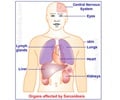A systematic approach to the diagnosis of pediatric interstitial lung disease is useful, and not all patients need lung biopsy for diagnosis
Chronic interstitial lung disease (ILD) comprises a large, heterogeneous group of rare pulmonary disorders characterized by diffuse infiltrates, restrictive lung disease, and abnormal gas exchange with considerable mortality and morbidity. ILD presents enormous diagnostic challenges because the differential diagnosis includes more than 100 conditions in both adults2 and children.
Researchers from Texas and Colorado conducted a descriptive, observational study was to evaluate the value of a systematic approach to the diagnosis of pediatric ILD. The study appears in the journal Pediatrics (vol. 101). In this prospective study, the researchers evaluated 51 children presenting with ILD of unknown etiology during a 3-year period. Specific clinical information regarding history, physical examination, diagnostic evaluation, and final diagnosis was recorded on each patient.A specific diagnosis was established by history and physical examination alone in 1 patient, noninvasive tests alone in 8 others, and invasive tests, including lung biopsy, in another 26. Of the remaining patients, 8 had a suggestive diagnosis, and 8 had no specific diagnosis.
In this study, all of the patients who did not have ITs are currently living, whereas all of the deaths or tranplant occurred in patients who had had ITs. Although the series was small, this observation suggests that the algorithm was utilized appropriately, reserving the most invasive studies for the sickest patients.
In conclusion, this study demonstrates that pediatric ILD comprises a heterogeneous group of mostly rare disorders that present tremendous diagnostic challenges. A systematic approach to the diagnosis of pediatric ILD is useful, and not all patients need lung biopsy for diagnosis.
The authors stress that a systematic evaluation will preclude the need for invasive tests in some patients. Although this series is one of the largest to be reported in children, the study suffers from small numbers relative to those reported for adult ILD. Because no single pediatric center can see large numbers of pediatric ILD patients, multi center collaboration will be required to extend these observations.
Medindia on Lung cancer:
Lung cancer is the uncontrolled growth of abnormal cells in the lung. Majority of people who get lung cancer have been cigarette smokers, but not all people who smoke get lung cancer. And, some people who have never smoked get lung cancer. Normal lung tissue is made up of cells that are programmed by nature to create lungs of a certain shape and function.










